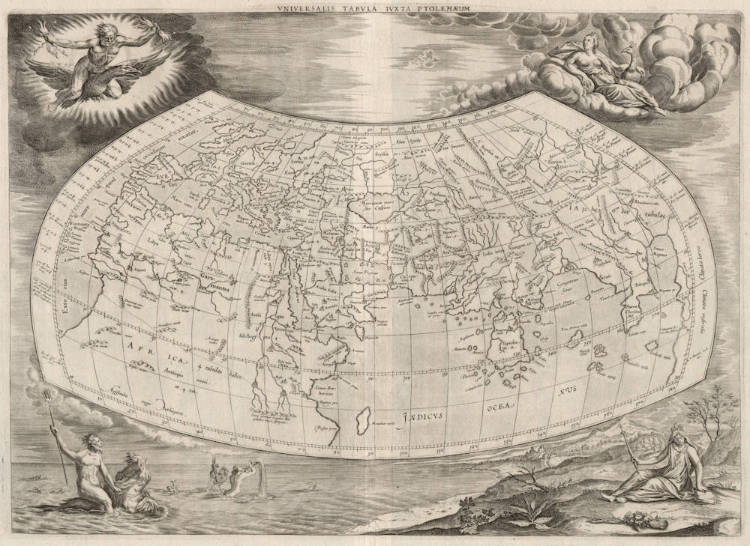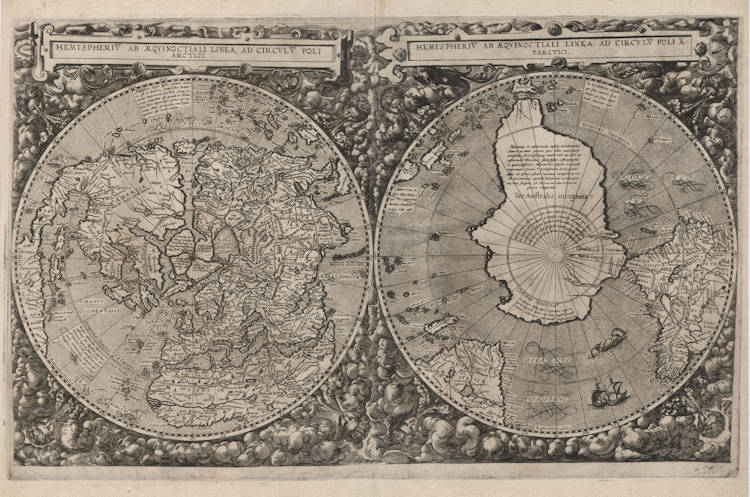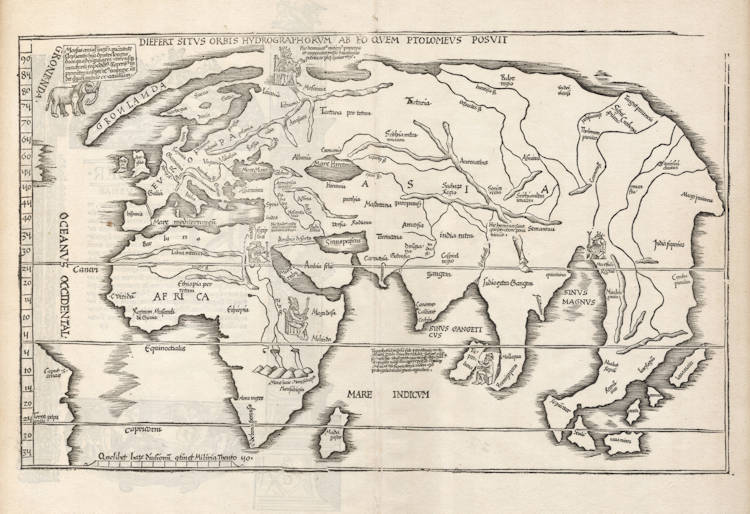Leen Helmink Antique Maps
Antique map of the World by Joan Blaeu
Stock number: 18908
Zoom ImageCartographer(s)
Joan Blaeu (biography)
Title
Nova et Accuratissima Totius Terrarum Orbis Tabula
First Published
Amsterdam, 1662
This Edition
1672 Spanish
Size
40.8 x 54.5 cms
Technique
Condition
mint
Price
$ 19,500.00
(Convert price to other currencies)
Description
Joan Blaeu's highly important map of the world in double hemispheres, used only in the magnificent Atlas Maior, a book for kings and princes, a grand showpiece, the most expensive and impressive book of the day, in twelve volumes containing more than 600 maps. It is the first and best map of the most magnificent work of its kind ever. It replaces the rectangular world map with decorated borders that his father Willem had produced as early as 1606, and which is all other atlases of the Blaeu publishing firm. For this reason, the map is much rarer than the regular world map by the Blaeu family.
Under the two hemispheres are allegoric representations of the the four seasons, a popular motif in Dutch graphic art. It expresses the need of mankind to establish order in the world.
The seasons along the bottom have been copied after a series of master print etchings by Antonio Tempesta. Spring is on the left, represented by a young girl holding flowers, riding a chariot that is drawn by baby calves and lambs, typically born in spring. Next to her is summer, a woman (probably Demeter, the goddess of harvest and agriculture), holding wheat and riding a chariot drawn by storks and doves. Storks as the symbol of birth and new life, doves for love. Autumn shows the triumph of Bacchus, or Dionysus, the god of grape-harvest, winemaking and wine, and of fertility. He is riding a chariot drawn by goats and doves. Goats were a symbol of fertility and goat skins were used for wine bottles when travelling. Doves the symbol of love. Winter is on the right, allegorically depicted by an old man warming his hands on a brazier set on a chariot drawn by owls and peacocks, symbols of wisdom and guidance.
The hemispheres are flanked by Claudius Ptolemy on the left, holding an armillary sphere and a pair of dividers, and Marinus of Tyre on the right, holding a globe and a pair of dividers. They represent the ancient sciences of the heavens and the earth, astronomy and geography. Interestingly, Joan Blaeu's father Willem Janszoon Blaeu had studied mathematics and astronomy with Tycho Brahe at his observatory on the island of Ven in Denmark, and had published detailed instruction books on the use of armillary spheres and spherical astrolabes.
The grand celestial scene in the upper section of the map has a mythological content, combining the seven planets with the gods of the Olympus, home of the gods of the upper world.
The figure on the left is Jupiter (Zeus), depicted with his symbols of the eagle and the arrows of lightning. Being the king of all gods and ruler of the upper world, he wears a crown and carries a scepter.
Next to him is Venus (Aphrodite), the goddess of love. She is holding a burning heart of love. Cupid and his arrow accompany her.
The following figure in the clouds with his petasus (winged helmet) caduceus (staff with intertwined snakes) is Mercury (Hermes), messenger to the gods and protector of trade and negotiation.
Mars (Ares), the god of war and also an agricultural guardian, is shown with his typical attributes of his helmet, shield and sword.
The old man in the upper right, with a scythe, depicts Saturn (Cronus), the forefather of the classical gods, also god of agriculture and harvest, and a symbol of the passing of time and history. Because of a prediction that one day a mighty son would overthrow him, he ate all of his children when they were born to prevent this. Cronus’s wife Rhea hid her sixth her sixth child, Zeus, and offered him a large stone wrapped in clothes which he promptly devoured. Zeus later managed to overthrow him.
These gods corresponded the five known planets, to complete the series of the seven known bodies of the solar system, loosely referred to as the seven planets, the sun is depicted in the upper center, brightly featuring as a halo for Christ, seated on his heavenly throne, with a scepter emphasizing his ruling of the universe.
The figure below Christ represents the moon, between the northern hemispheres. It is Satan, the anti-Christ, in the form of Lucifer, the fallen angel, with the crescent moon symbolizing his horns.
As often in 17th century Dutch iconography, from all the important gods of mythology two are missing, namely Neptune (Poseidon), god of the sea, and Pluto (Hades), ruler of the underworld, but this is a representation of the seven planets and a depiction of the Olympus or home of the gods. Jupiter, Neptune and Pluto were brothers who together presided over the realms of heaven, the earthly world and the underworld. Note that the distant planets Uranus, Neptune and Pluto were not discovered or identified as planets until the 1800s and 1900s, and were accordingly named after Roman gods.
The ancient mythology and symbolism from classical antiquity, together with the christian elements, the heavens and the earth, astronomy and geography, together with the four seasons and the seven planets depict a cosmic order in which everything is related in one global harmony.
The map is a reduced version of Joan Blaeu's monumental 1648 wall map of the world, engraved in 21 plates of copper. That wall map was made to coincide with the Peace of Munster, a treaty part of the Peace of Westphalia, that put an end to the Eighty Years' War between the Seventeen Provinces of the Netherlands and the Spanish Empire. In the peace treaty, Spain and the major European powers definitely recognized the Dutch Republic as an independent country no longer part of the Holy Roman Empire. The 21 sheet wall map has a congratulatory dedication to Casparo de Bracamonte, the spanish ambassador at the peace conference. The map has been lauded as the finest expression of Dutch cartography at the highest point of its development. Nearly all areas of the world have been carefully redrawn to incorporate the latest information out of Dutch and other voyages of discovery to which Joan Blaeu had access in his role as chief cartographer to the East India Company. Blaeu's world outline thus established a pattern which was followed by virtually all succeeding maps until the last decade of the century.
"Since its appearance as an Appendix in 1630, the atlas launched by Willem J. Blaeu and continued by his son Joan had expanded greatly. But in spite of many new regional maps the general [world] map in volume I — taken from a plate engraved in 1606 — remained unchanged. For some reason Joan Blaeu's important wall map of 1648 was not immediately adapted by his firm for atlas use although it was copied in reduced form by other Dutch cartographers.
The new world map prepared by Joan Blaeu for his eleven-volume Atlas Maior in 1662 is, unlike its predecessor, in two hemispheres.
As with all productions by the firm of Blaeu, the engraving and layout and elegance of decoration are all of the highest standard. The map is invariably printed on thick paper of quality and often superbly handcoloured. Outside the twin hemispheres at the top are celestial figures seated amid clouds: below are representations of the four seasons with each allegorical figure seated in an appropriate chariot quaintly drawn by pairs of beasts and birds.
After the Latin-text edition of 1662, Blaeu's Atlas Maior appeared with French text in 1663, Dutch text in 1664, with French text again in 1667 and with German text in the same year. An incomplete Spanish-text edition was made up after the fire in 1672 which ravaged the Blaeu printing works and destroyed many of the plates. The world map plate seems to have survived and, after the sale of many maps and plates between 10 and 1677, have come into the hands of the Van Keulen family. It is found in some Van Keulen atlases of 1681, 1682 and 1685."
(Shirley 371 and 428)
"Blaeu's superb double hemispherical map is one of the earliest world maps to incorporate Tasman's discoveries in Australia and New Zealand. On some examples of this map the ghosting of Tasman's 1642-43 track is visible."
(Simon Dewez)
Willem Janszoon Blaeu (1571-1638)
Joan Blaeu (son) (1596-1673)
Cornelis Blaeu (son) (?-c.1642)
Willem Janszoon Blaeu died in October 1638, leaving his prospering business to his sons, Joan and Cornelis, who continued and expanded their father's ambitious plans.
After the premature death of his brother Cornelis in 1642, Joan directed the work alone and the whole atlas series of 6 volumes was eventually completed about 1655. As soon as it was finished he began the preparation of the even larger work, the Atlas Maior, which reached publication in 1662 in 11 volumes (later editions in 9-12 volumes) and contained nearly 600 double-page maps and 3,000 pages of text. This was, and indeed remains, the most magnificent work of its kind ever produced; perhaps its geographical content was not as up-to-date or as accurate as its author could have wished, but any deficiencies in that direction were more than compensated for by the fine engraving and colouring, the elaborate cartouches and pictorial and heraldic detail and especially the splendid calligraphy.
In 1672 a disastrous fire destroyed Blaeu's printing house in the Gravenstraat and a year afterwards Joan Blaeu died. The firm's surviving stocks of plates and maps were gradually dispersed, some of the plates being bought by F. de Wit and Schenk and Valck, before final closure in about 1695.
(Moreland and Bannister)
Related Categories
Related Items






